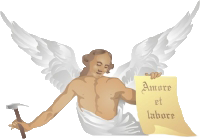Berg Klösterle
The church
The church "Little Maria Zell" is splendidly equipped with statues and frescoes from the mid-18th century. It is still in use on Sundays and feast days. It is a very well-preserved church with magnificent Baroque paintings. In the long house, there are paintings depicting four scenes from the gospels. There are paintings of Carmelite saints in medallions and Elias in his chariot against the sky. At the centre of the ceiling there is a painting of Our Lady in black.
Behind the organ you can see paintings of King David and St. Cecilia. The banners with chronogram: left "Teresia Imperatrix Regina Hungariae atque Archidux Charinthiae erexit" and the right "Clagenfurtensis vero inclytus et regius religionis consessus ecclesiam ut exstat renovavit." Each one of the red-tinged Latin letters is a numeral. When you add them together you will come to the year when the monastery was built.
After a fire in 1754 the church was renovated from 1760 onwards. The paintings in the choir are stylistically somewhat different from those of the long house. They provide a good example of illusionist frescoes.
In the altar dome, exotic motives such as a Negro, an Indian and an American as representatives of the people in the Habsburg empire. Together with Maria Theresa, they represent the more modern and more cosmopolitan Catholic church.
The Church, dedicated to Our Lady, was built in 1754, by Maria Theresa,along with the monastery. The Madonna on the high altar has an altar shrine. The statue of Our Lady is probably about 200 years older. The statue of Our Lady for this church was consecrated in 1754.
Maria Theresa wanted to create a Marian pilgrimage site with the Order of Carmelites praying here, to oppose the strong influence of the Protestants in the area. Her son, Emperor Joseph II, dissolved the monastery in 1786, as well as many other monasteries. Since then, it was in use as a rectory, school room and dwelling for the villagers.
The 250 years celebration was held on 28th August 2004.
The church is also well known for its Baroque organ and for its excellent acoustics.
For these reasons, and because of its position far from road traffic, the church was used by the Austrian Broadcasting company for several choral recordings. Because this church was always in a Protestant dominated area, not so many candles were burned and so the magnificent original Baroque decoration remained untouched in the church and did not require any restoration.























